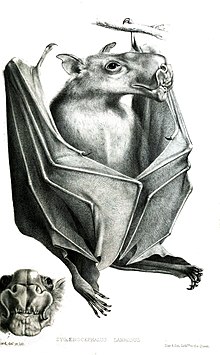Hypsignathus
| Hammer-headed bat | |
|---|---|
 |
|
| Scientific classification | |
| Kingdom: | Animalia |
| Phylum: | Chordata |
| Class: | Mammalia |
| Order: | Chiroptera |
| Suborder: | Megachiroptera |
| Family: | Pteropodidae |
| Genus: |
Hypsignathus H. Allen, 1861 |
| Species: | H. monstrosus |
| Binomial name | |
|
Hypsignathus monstrosus Allen, 1861 |
|
 |
|
| Hammer-headed Bat range | |
The hammer-headed bat (Hypsignathus monstrosus), also known as the big-lipped bat, is a megabat widely distributed in equatorial Africa. This large bat is found in riverine forests, mangroves, swamps, and palm forests at elevations less than 1,800 metres (5,900 ft).
The hammer-headed bat is a member of the family Pteropodidae. Pteropodidae is divided into two subfamilies, Macroglossinae which contains six genera, and Pteropodinae containing thirty-six genera including Hypsignathus. The family Pteropodidae is found within the suborder, Megachiroptera. This group is commonly referred to as the megabats or flying foxes.
The hammer-headed bat is the largest bat in Africa with a wingspan of 686 to 970 mm (27.0 to 38.2 in) and a total length of 195 to 285 mm (7.7 to 11.2 in). Males, ranging from 228 to 450 g (8.0 to 15.9 oz), are significantly larger than females, which range from 218 to 377 g (7.7 to 13.3 oz).
Pelage is grey-brown to slaty-brown with a whitish collar of fur extending from shoulder to shoulder. The flight membranes are brown and the ears are dark brown with a tuft of white fur at the base. The face is dark brown with a few long, stiff whiskers around the mouth.
The skull may be diagnosed by specific dental features. The second premolar and molars are markedly lobed. This feature is specific for this genus, and no other African fruit bats have this characteristic.
There is extreme sexual dimorphism in this species. The male possesses an enormous head for producing loud honking calls. The enlarged rostrum, larynx and lips allow these sounds to be extremely resonant. The larynx is one half the length of the vertebral column and fills out most of the thoracic cavity. It is nearly three times larger in males than females. The male also has a hairless split chin and warty rostrum with wrinkled skin around it. Females have a much more fox-like appearance similar to most fruit bats.
Hammer-headed bats are frugivores. Figs make up much of their diet, but they may also include mangos, bananas and guavas. There are some complications inherent in a fruit diet such as insufficient protein intake. It is suggested that fruit bats compensate for this by possessing a proportionally longer intestine compared to insectivorous species. This enhances their ability to absorb protein. They also have very rapid digestive systems allowing these bats to assimilate high amounts of fruit to ensure that adequate protein is absorbed. It is also suggested that by eating a wide variety of fruits with varying protein contents, fruit bats are able to maintain an entirely frugivorous diet.
...
Wikipedia

